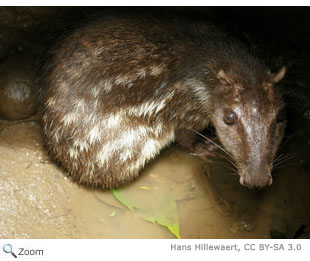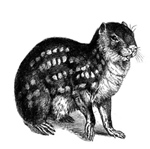 There are two species of large rodents in this family. There are two species of large rodents in this family.
Pacas are found in the forests in Central and South America and weigh around 20 pounds. They have reddish-brown fur with rows of white spots.
They have very, very small tails; large heads; cheek pouches; and small, round ears. Their hind legs are longer than their front legs. They have three clawed toes on their rear feet and four clawed toes on their front feet.
Pacas use their clawed feet to dig burrows in stream and pond banks, at the base of trees, or among the rocks. Their burrows have more than one entrance. Pacas eat fruits, nuts, seeds, and plants. They are good swimmers. Pacas live alone or in pairs.
World Status Key
 Least Concern Least Concern  Near Threatened Near Threatened  Vulnerable Vulnerable  Endangered Endangered  Critically Endangered Critically Endangered  Extinct in Wild Extinct in Wild  Extinct Extinct  Not Enough Data Not Enough Data
Status and range is taken from ICUN Redlist.
Location Key
 Africa Africa  Asia Asia  Australia/Oceania Australia/Oceania  Europe Europe  North America North America  South America South America  NH NH  Click for More Info Click for More Info  Click for Image Click for Image
New Hampshire Species |
|
North/Central American Species |
| None |
|
Spotted Paca- Cuniculus paca     
|
Other Species Around the World |
Mountain Paca - Cuniculus taczanowskii    |
|
|
Additional InformationKey:  Profile Profile  Photos Photos  Video Video  Audio Audio
Mountain Paca - Cuniculus taczanowskii   
The mountain paca is found in Venezuela, Colombia, Ecuador, Peru and Bolivia.
Source: Arkive Intended Audience: General Reading Level: Middle School
Mountain Paca - Cuniculus taczanowskii    
The mountain paca lives near rivers or swampy areas in dense forest thickets.
Source: Animal Diversity Web Intended Audience: General Reading Level: Middle School
Spotted Paca - Cuniculus paca     
The spotted paca is also known as the lowland paca. It is found in Argentina, Belize, Bolivia, Brazil, Colombia, Costa Rica, Ecuador, El Salvador, French Guiana, Guatemala, Guyana, Honduras, Mexico, Nicaragua, Panama, Paraguay, Peru, Suriname, Trinidad and Tobago, Uruguay, and Venezuela.
Source: Animal Diversity Web Intended Audience: General Reading Level: Middle School
|
 There are two species of large rodents in this family.
There are two species of large rodents in this family.

